Scraping Bagpipe Chanter Reeds
 Ask twenty pipers the question “how do you scrape a chanter reed?” and you will likely get twenty different answers. There are as many treatments as there are chanter reeds to treat. Even SFU’s Jack Lee admitted as much in his recent discussion on Bagpipe Nation. In that conversation, he described his approach to “the shave,” that is, how to scrape the chanter reed to rejuvenate it and work in its sound and performance to your liking. The scrape though, is not all cut and dry (excuse the pun). There are several approaches that all work well depending on a variety of factors: the reed’s construction (molded vs. ridge-cut); how much material might exist on the blades; whether you are a wet or dry blower; your personal strength preferences; etc. The trick is knowing which approach will work for you and that is going to require experimentation, as well as (I hate to break it to you) ruining some reeds.
Ask twenty pipers the question “how do you scrape a chanter reed?” and you will likely get twenty different answers. There are as many treatments as there are chanter reeds to treat. Even SFU’s Jack Lee admitted as much in his recent discussion on Bagpipe Nation. In that conversation, he described his approach to “the shave,” that is, how to scrape the chanter reed to rejuvenate it and work in its sound and performance to your liking. The scrape though, is not all cut and dry (excuse the pun). There are several approaches that all work well depending on a variety of factors: the reed’s construction (molded vs. ridge-cut); how much material might exist on the blades; whether you are a wet or dry blower; your personal strength preferences; etc. The trick is knowing which approach will work for you and that is going to require experimentation, as well as (I hate to break it to you) ruining some reeds.
A handy guide to help you as you experiment with the shave, or scrape, is downloaded here or by clicking the image below. As always, there are no hard and fast rules and all techniques may fail until you develop the right touch.
The Basics
The general idea behind taking off reed material by scraping or sanding the blades is that it will free up the cane of the reed to make it easier to vibrate as well as smooth out the rougher edges of the pitch. Depending on the amount material on the reed, and how much you take off, overall timbre can be flattened, or mellowed, along the scale. The more material you take off, the more the balance of the notes on the chanter will be changed. A new reed that gives an “off-balance†scale in your chanter can sometimes be corrected by taking away material across different areas of the reed blades. Be judicious with the amount of material you scrape away, removing small amounts each time. Remember, once it comes off, you can’t put it back!
Treating the scraping area in sections up the chanter scale will tell you about where to sand or scrape in order to better balance the notes. The general idea is that altering the upper parts of the reed will have an effect on the upper hand notes, and altering the lower part of the blades will have an effect on the lower hand notes. The effect of this will be different reed to reed depending on the make and construction and the aggressiveness of the scrape.
Always scrape a chanter reed with sharp Xacto blade or use fine grain sandpaper. Always try to scrape with the “grain.†When scraping with a blade, keep the reed in the chanter and grip the chanter bulb with the reed blades facing your body. Hold tightly and make light, slow scrapes toward you away from the reed binding. When sanding, place the sandpaper over the side of a table, countertop or other squared edge. Grip the reed by the staple and lightly move up and down and back and forth. With either method, start with just a few movements at a time. Try to make equal scrapes with equal pressure on both sides of the chosen scrape zone, on both sides of the reed.
Reed Scrape Method 1: Stay in the Box
 This method takes material away from the area at the base of the blades just above the binding and no higher than halfway up the reed body—in other words, the area of the sound box. Keep away from the edges and stick to the area in the vertical center of the reed blades. Light scrapes equally across the area on both sides of the reed should keep the reed’s general resonance and character while freeing up the cane to affect the whole scale.
This method takes material away from the area at the base of the blades just above the binding and no higher than halfway up the reed body—in other words, the area of the sound box. Keep away from the edges and stick to the area in the vertical center of the reed blades. Light scrapes equally across the area on both sides of the reed should keep the reed’s general resonance and character while freeing up the cane to affect the whole scale.
Reed Scrape Method 2: The Bowtie
 The bowtie method scrapes material in a curved “parabola” shape or “U” starting in the upper half of the reed blade. Scrape lightly along the edges to meet in a curve with the majority of scraping done in the parabola shape across the upper part of the sound box in the center of the reed body. The total area becomes a bowtie-like shape in the center of the reed. The effect of this technique is heard in larger changes in certain notes of the scale.
The bowtie method scrapes material in a curved “parabola” shape or “U” starting in the upper half of the reed blade. Scrape lightly along the edges to meet in a curve with the majority of scraping done in the parabola shape across the upper part of the sound box in the center of the reed body. The total area becomes a bowtie-like shape in the center of the reed. The effect of this technique is heard in larger changes in certain notes of the scale.
Reed Scrape Method 3: Out on the Edge
 The edge method takes material away along the edges of the entire length of the blades just shy of the tip. Typically, a bit of material is taken off the bottom two-thirds of the blades along the edges only. This has the effect of freeing up the cane to make the reed easier to play while retaining all the resonance the sound box can produce by leaving it be. This method can also flatten the overall pitch of the reed as well as effect its stability over time.
The edge method takes material away along the edges of the entire length of the blades just shy of the tip. Typically, a bit of material is taken off the bottom two-thirds of the blades along the edges only. This has the effect of freeing up the cane to make the reed easier to play while retaining all the resonance the sound box can produce by leaving it be. This method can also flatten the overall pitch of the reed as well as effect its stability over time.
Reed Scrape Method 4: Blade Shave
 This method is a more drastic approach that sticks to alterations on the blades only. It is not easily (or typically) done with ridge-cut reeds. In round-body or “molded” reeds, this method follows the same parabola as in the bowtie method but in reverse. Sanding or scraping on the blades will lower pitch on particular notes of the scale determined by how high up the blades you scrape (i.e., the lower portion of the scrape zone will affect the lower hand notes; scrapes in the upper portion will affect the top hand notes).
This method is a more drastic approach that sticks to alterations on the blades only. It is not easily (or typically) done with ridge-cut reeds. In round-body or “molded” reeds, this method follows the same parabola as in the bowtie method but in reverse. Sanding or scraping on the blades will lower pitch on particular notes of the scale determined by how high up the blades you scrape (i.e., the lower portion of the scrape zone will affect the lower hand notes; scrapes in the upper portion will affect the top hand notes).
 Pipehacker
Pipehacker









